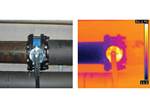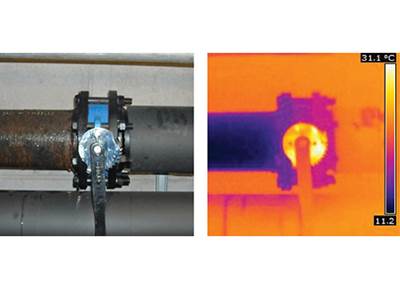Energy Miser: For Energy-Efficient Water Cooling, Raise Temperatures to Cut Demand
14th in a series
Many plants use chilled-water temperatures that are far lower than are actually needed by the process. This has a direct effect on the cost of chilled water.
In the May issue, we covered the first stage in implementing an energy-efficient cooling water program—minimizing “parasitic” heat gains. The second stage in the cooling-water program is to increase the flow temperatures to the maximum possible. This will minimize the cooling loads and reduce costs. While this may seem obvious, many plants are using water temperatures that are far lower than actually needed because they have never questioned the temperature settings.
Process cooling is a major energy user in injection molding, and many processors use a split system as shown in the first illustration. This type of system consists of two main components:
1) Chilled water for mold cooling and temperature control. This is generally operated with a flow temperature in the region of 40 to 60 F and uses chillers. This chilled water needs to be well controlled because variations in the flow temperature will affect both productivity and the product dimensions.
2) Cooling water for machine hydraulics. This is generally provided by cooling towers operating in the region of 60 to 80 F. Machine cooling is generally non-critical—i.e., as long as the hydraulic oil is not allowed to get too hot (over about 95 to 105 F) then most machines will operate perfectly happily. If the hydraulic oil becomes too hot, then oil degradation will take place and the upper heating limit is effectively set by the temperature at which this occurs. While the exact temperature of the oil is not critical, it is desirable to have a stable temperature to provide consistent machine operation.
This type of split system is very energy efficient and provides control where it is needed and the required temperature where it is needed. In sum: Split systems enable processors to use the chilled and cooled water systems to their best advantage. (Other processes, such as extrusion, use different temperatures for process control but the basic principles remain the same.)
RAISE CHILLED-WATER TEMPERATURES
Many plants use chilled-water temperatures that are far lower than are actually needed by the process. This has a direct effect on the cost of chilled water. Every 1º F temperature rise in the chiller flow temperature will reduce the energy required for cooling by about 2%, and overcooling is often a large factor in excessive energy use. If the chilled-water flow temperature is set at 50 F and can be raised to 60 F, this will reduce chiller costs by about 20%. In many cases this temperature increase can be achieved with little effect on the process, but with substantial reductions in energy costs.
Even a small injection molding plant will need at least 60kW of input cooling power. For a 24/7 operation at an energy cost of 10¢/kWh, this will cost around $50,000/yr to operate. A 20% saving is therefore about $10,000/yr. A project to increase chiller setpoints would cost about $6000 for the necessary tests, and at small plants this project would have a payback of about seven months.
At larger sites, the payback will be very similar but the project cost will be more.Where multiple chillers are used, it is common to find that they have different setpoints. In this case, the first remedial action is to get the chilled-water temperatures consistent across the plant.
As a first step, choose the highest reliable temperature setting and synchronize all other settings with this. Then raise the setpoint on all the chillers by 1° F and note the results in production.
Check for any problems with machines or processes. Investigate and solve the problems. Wait a week and then increase the setpoint by 1°F on all the chillers again. Increase setpoints yet again until a uniform setpoint of at least 60 F is reached or the setting is maximized for your production.
•Tip: Be careful of using uncalibrated thermometers when setting chilled-water temperatures. The setpoint on the chiller display may not be accurate, and in-line dial thermometers should be treated with care.
•Tip: Excessively low setpoints will increase problems such as “mold sweating” (condensation on the cold mold) during summer.
•Tip: Deliver water at the highest possible temperature for the process. If small users need lower temperatures then consider a separate stand-alone chiller system, provided it is not too big.
•Tip: In most cases, the production staff will campaign for lower chilled-water temperatures, in the belief that they can provide shorter cycle times and faster production. Challenge this wisdom by increasing the temperatures and seeing if they actually notice the difference.
•Tip: Increasing the chilled-water flow temperature increases the possibility of using air-blast cooling as precooling (or as full cooling in cold weather). The benefits of air-blast cooling will be covered in a later article.
OTHER TYPES OF SYSTEMS
Some processors use a single-line system instead of a split system, meaning that they use chilled water for cooling machine hydraulics. This can be effective if the chilled-water flow to the hydraulics is adequately controlled by a thermostatic valve, i.e. it only operates to keep the hydraulics at around 80 F and not at the flow temperature of the chilled water.
If the chilled-water flow is uncontrolled, then this is a very expensive method of providing machine cooling and the operating costs of the chillers will soon (<1.5 yr) exceed the capital cost of installing the piping for a second machine cooling system.
Keep in mind: Using chilled water for hydraulic systems cooling is expensive compared with cooling towers or air-blast cooling.
RAISE COOLING-WATER TEMPERATURE
Increasing cooling-water flow temperatures will generally have only a minor benefit, as cooling water (unlike chilled water) is commonly provided by low-cost methods such as cooling towers or air-blast cooling. Nonetheless, raising the flow temperature can reduce tower fan operation and trim costs marginally.
The most important aspect of a cooling tower is to improve the water-temperature control. Cooling towers are designed to achieve a specific amount of cooling at a design dry bulb/wet bulb temperature, but for most of the year the ambient temperatures will be below this.
If temperature controls are not used, the system may deliver water at a variable temperature and this can affect process control and process stability.
•Tip: When tower water is used for cooling a chiller or compressor, the temperature should be as low as possible to improve the efficiency of the chiller or compressor.
Related Content
Chiller Lines Updated to EPA-Approved Refrigerants
Thermal Care’s chillers now utilize EPA-approved low Global Warming Potential (GWP) R‐454B and R‐513A refrigerants.
Read MoreWater Temperature Control Upgraded and Integrated into Machine Control
Engel’s new eco-flomo temperature control system continuously monitors injection mold cooling and temperature control circuits, displaying pressure, temperature and flow rate values.
Read MoreTroubleshooting Leaky Temperature-Control Units
Learn the causes, symptoms and remedies for TCU leaks to keep these vital contributors to plastics processing up and running longer and more efficiently.
Read MoreFollow These Best Practices When Working With Heat Transfer Fluids
Effectively choosing, operating and maintaining thermal fluid can positively impact productivity in plastics processing.
Read MoreRead Next
Introduction to Cooling Water Energy Management
A reliable and consistent source of cooling is essential in plastics processing.
Read MoreCooling Water: Minimize Demand by Reducing Heat Gains
In March, we introduced the subject of energy savings through cooling-water management.
Read MoreFor PLASTICS' CEO Seaholm, NPE to Shine Light on Sustainability Successes
With advocacy, communication and sustainability as three main pillars, Seaholm leads a trade association to NPE that ‘is more active today than we have ever been.’
Read More





















